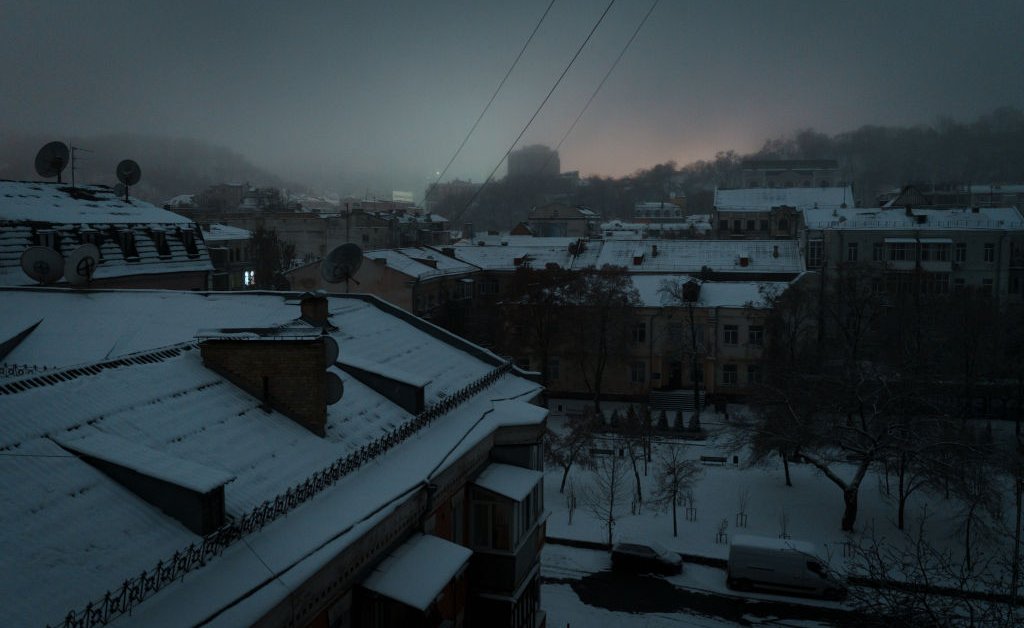It’s December, especially in Ukraine, where temperatures in some cities are already as low as 20 degrees Fahrenheit. Snow is falling country-wide. And at any given moment at least two and as many as ten million Ukrainians have no power, heating, or water because Russia is systematically targeting Ukraine’s utilities—its nervous system—with rocket and drone strikes. Although Ukrainian electrical technicians are heroically repairing the damage as fast as possible, absent hundreds of millions of dollars and urgent equipment donations, many Ukrainians could die in the next few months.
On December 10, according to Ukrainian President Volodymyr Zelensky, Russian forces launched 15 drone attacks at Ukraine. Two thirds were intercepted by Ukrainian defense systems, but the remaining drones pulverized Odesa’s electrical substation, leaving more than 1.5 million Ukrainians without power. Snow is forecast for this week and night temperatures in the 20s and 30s. The Odesa Regional State Administration issued a public service announcement that repairs could take 2-3 months.
Such attacks are becoming routine. Putin is trying to make Ukraine uninhabitable. While Ukrainians’ morale has withstood thus far, days or even months of intermittent internet, phones, water, heating, and light could chip away at their resilience, resolution, and fighting spirit. Or so Putin hopes.
The December 10 barrage was the ninth such wave of attacks, and relatively mild by comparison. Worse attacks have been tragically routine since September. On December 5, Russia fired over 70 missiles with remarkable precision at various Ukrainian energy infrastructure targets. Sixty were shot down by Ukraine. The ones that hit contributed to the mounting toll of the almost daily barrages on power plants, heating stations, water utilities, and their distributions systems. Half of the Kyiv region lost power. Other areas of the country fared little better. According to electricity grid operator Ukrenergo, blackouts were still widespread as of the weekend, and those lucky enough to have electricity are at immediate risk of losing it as demand outstrips supply. In the December 5 onslaught, DTEK, Ukraine’s largest private power company and the owner of most of the country’s thermal power plants (TPPs), lost two of its eight power plants. One is now back online but the other is still undergoing repairs. The rest had already been seized or bombed or preemptively taken offline.
Over all, Russia has launched more than 1,000 rockets and missiles at Ukraine’s electricity grid alone. One wave of attacks hit 12 regions with 83 missiles and 17 Iranian kamikaze drones on October 10-12, just after the Kerch Straight Bridge bombing. It damaged 18 power plants, including eight of the country’s 14 TPPs. Another hit October 21-22 with 33 cruise missiles. Another on October 31. Another on November 15-17, this time with 92 rockets that left almost 11 million households, about half the population of Ukraine, dark and cold. Another hit November 23 with over 70 missiles. This is just a sampling. At least 77 civilians have been killed, with over 272 injured.
Read More: TIME’s Person of the Year: Volodymyr Zelensky
After what is now almost three months of energy infrastructure strikes, the consequences are devastating. Every single Ukrainian thermal (coal or natural gas) and also hydro power plant has been damaged, although not all to the point of full inoperability. Almost every electrical substation has been hit, mostly with Iranian kamikaze drones that are almost impossible to defend against. More than 40% of the electrical grid has been damaged. And meanwhile, equipped with Soviet era maps of Ukraine’s power grid, Russia is targeting sites it previous struck to ensure Ukraine can’t stabilize. At least one electrical technician was killed by a repeat Russian strike while repairing the damage from the first one on the same substation.
Candles light a restaurant during a power cut in downtown Kyiv on December 6, 2022, amid the Russian invasion of Ukraine. – With temperatures dipping below zero, repeated Russian attacks have left Ukraine’s energy grid teetering on the brink of collapse and have disrupted power and water supplies to millions over recent weeks.
Dimitar DILKOFF- AFP
Ukraine’s electricity generation capacity is down 50% just as it struggles to power and heat itself during winter. Much of the drop is because the Zaporizhzhia Nuclear Power Plant, which accounts for at least 20% of the country’s generation capacity, is offline to protect it from Russian shelling. Renewables (wind and solar) are usually at least 10% of Ukraine’s power mix, but they are offline, too, because they’re mostly located in Russian occupied areas in the south. Only two of Ukraine’s TPPs are operating properly, and even they are damaged. Many if not most hydroelectric plants are down. The situation is so dire that even with power consumption 40% lower than this time last year, Ukraine is nonetheless short 27% (as of November 30) of its electricity needs. This deficit has been much higher immediately after a Russian attack. As a consequence of the cumulative disaster, every single region of Ukraine is under emergency declarations that permit blackouts. Meanwhile, Ukraine’s electricity import capacity can only meet 10% of the country’s needs, leaving a gap big enough to ensure at least a few million Ukrainians are in the dark at any given moment.
Ukrainian technicians—70 teams, over 1,000 specialists—are genuinely valiant in their efforts to repair the damage and restore electricity, heat, and sometimes water to besieged citizens. But it’s whack-a-mole. As they fix one transmission line or substation, Russia hits another, or sometimes even the one they just restored. The December 10 attack on Odesa’s substation came literally just after electricity had been restored following December 5 strikes.
The damage is around $2 billion now. The U.S. has pledged $53 million specifically for energy infrastructure repairs. Norway is sending $100 million. The European Council will offer €18 billion in 10-year loans that can be used to rebuild infrastructure. The Netherlands and the European Bank for Reconstruction and Development are propping up Ukrenergo. Others have promised to help as well. The United Nations Development Program and World Bank are trying to secure new transformers and other grid equipment for Ukraine, as are many governments and both foreign public and private energy companies. Unfortunately, however, Ukraine has mostly run out of spare parts, and in the West equipment that is compatible with Ukraine’s outdated, Soviet era grid is hard to find.
This is a real emergency. Recent estimates of how bad things could get in Ukraine due to the loss of energy infrastructure are bleak. For comparison, according to the Economist, 32,000-335,000 people will die in the European Union (plus the U.K., Norway, and Switzerland) this winter due to high energy prices. 147,500 will die if prices stay at their current level, with more or fewer depending on how cold the weather gets. That’s just for more expensive energy.
But in Ukraine, people are facing the total loss of energy, and heating and water, and for at least several days’ duration over repeated sporadic periods, and for as long as Russia has rockets or Iranian drones to launch and a continuing appetite for atrocities. The World Health Organization regional director for Europe, Dr. Hans Kluge, estimated in late November that millions of Ukrainians are in danger of death from a combination of exposure to cold, increased illness rates, lack of treatment for illness because of limited transportation options and closed hospitals, burning dangerous alternate fuels, and more.
It’s hard to imagine a life without electricity these days. The loss of heating in sub-zero temperatures is self evidently dangerous. It is harder to wrap one’s head around the importance of electricity, however. And yet, it cannot be overestimated. Without it, internet routers don’t provide wifi. Telecommunications towers don’t transmit cellular signals. Hospitals cannot keep blood warm for transfusions, or operate kidney dialysis machines. Electric trollies, buses, and subway systems don’t run. Food cannot be cooked. Military supply chains may break down. In the dark of winter, schools and business are limited to short daylight hours. And when you are cold, perpetually scared or bored, possibly hungry, and in the dark, surely morale must begin to wilt. If only morale were the only victim.
Human Rights Watch has declared Russia’s “deranged” attacks on Ukrainian energy infrastructure a violation of the laws of war because they are clearly designed to terrorize civilians. The deliberate effort to freeze and starve Ukraine to death is further evidence of Putin’s genocidal mania. Sadly, he is not alone in this. Russians have supported his energy attacks on Ukraine. Russian MP Boris Chernyshov hoped Ukrainians would “freeze and rot.” MP Andrei Gurulyov urged Russia to “finish off” Ukraine’s power grid and then set to the banking system, “If we bomb the centre of their banking operations, they won’t be able to transfer anything anywhere, cards won’t work and people won’t get their paychecks.” Although some have expressed horror at Putin’s terror campaign against Ukrainian civilians, many others have expressed similarly supportive sentiments.
It’s not working—yet. Ukrainians have surprised the world, and certainly the Russians, many times in the last ten months of war by refusing to lose. They have stood firm in the face of odds most believed to be insurmountable. Whether a winter without heat and light and more dents their resolve has yet to be seen, but Putin is clearly hoping it does. Despite pronouncements from regular Ukrainians and politicians that they will ride the winter out undeterred whether or not they have power and heat, and from Kyiv that all energy infrastructure damage will be repaired and the national will shall not break, the situation is grim. Let us hope Russia runs out of rockets and drones before the weather worsens further.
More Must-Reads From TIME



